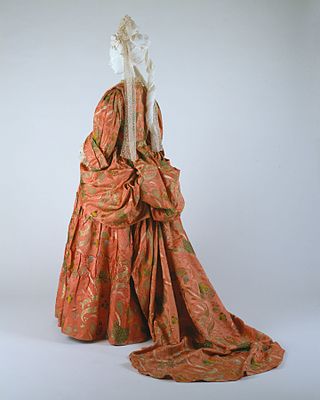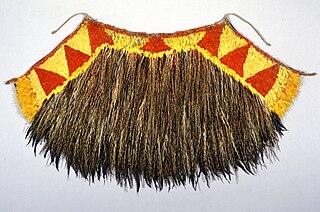This article needs additional citations for verification .(April 2023) |
A bulak or bulaki is an ornament or jewellery item that is a part of traditional attire of women ni Northern India and Nepal.
This article needs additional citations for verification .(April 2023) |
A bulak or bulaki is an ornament or jewellery item that is a part of traditional attire of women ni Northern India and Nepal.
Bulak is a type of nose ring worn at the nasal septum. It is usually worn by married women and is generally made out of 10-12 gram pure gold. It is peculiarly designed by the skillful goldsmiths who carve intricate motif designs on it. The average length of a bulak can be up to 4–5 cm along with a hook-like end, so that it could be worn easily. The bottom part of a bulak has intricate carving on it and the pearls are in a conical shape giving it an elegant look. The hook at which the bulaq is worn, resembles the inverted 'U' of the English alphabet.
In former years, it was adorned by the women of Garhwal, Kumaon and of Jaunsar belt. But nowadays the trend for bulak is diminishing and considered an old fashion. Apart from Uttarakhand, it is also worn in the state of Himachal Pradesh and in Nepal.

Jewellery consists of decorative items worn for personal adornment, such as brooches, rings, necklaces, earrings, pendants, bracelets, and cufflinks. Jewellery may be attached to the body or the clothes. From a western perspective, the term is restricted to durable ornaments, excluding flowers for example. For many centuries metal such as gold often combined with gemstones, has been the normal material for jewellery, but other materials such as glass, shells and other plant materials may be used.

The Victoria and Albert Museum in London is the world's largest museum of applied arts, decorative arts and design, housing a permanent collection of over 2.27 million objects. It was founded in 1852 and named after Queen Victoria and Prince Albert.

Nose piercing is the piercing of the skin or cartilage which forms any part of the nose, normally for the purpose of wearing jewelry, called a nose-jewel. Among the different varieties of nose piercings, the nostril piercing is the most common.

An earring is a piece of jewelry attached to the ear via a piercing in the earlobe or another external part of the ear, or, less often, by some other means. Earrings have been worn by people in different civilizations and historic periods, often with cultural significance.

A button is a fastener that joins two pieces of fabric together by slipping through a loop or by sliding through a buttonhole.

Sindoor or sindura is a traditional vermilion red or orange-red cosmetic powder from the Indian subcontinent, usually worn by married women along the part of their hairline. In Hindu communities, the sindoor is a visual marker of marital status of a woman and ceasing to wear it usually implies widowhood.

A chatelaine is a decorative belt hook or clasp worn at the waist with a series of chains suspended from it. Each chain is mounted with useful household appendages such as scissors, thimbles, watches, keys, smelling salts, and household seals.

A mantua is an article of women's clothing worn in the late 17th century and 18th century. Initially a loose gown, the later mantua was an overgown or robe typically worn over stays, stomacher and either a co-ordinating or contrasting petticoat.

Zachary E. Posen is an American fashion designer.

The dashiki is a colorful garment that covers the top half of the body, worn mostly in West Africa. It has formal and informal versions and varies from simple draped clothing to fully tailored suits. A common form is a loose-fitting pullover garment, with an ornate V-shaped collar, and tailored and embroidered neck and sleeve lines. It is frequently worn with a brimless kufi cap and pants. It has been popularized and claimed by communities in the African diaspora, especially African Americans.

The Dhaka topi, or Nepali topi, is a hat which is popular in Nepal, and which forms part of Nepalese national dress, worn by men on celebrations.

Margaret Layton's jacket is a surviving example of English Jacobean embroidery, significant because it appears in a portrait which has also survived. The jacket was originally owned and worn by Margaret Layton (1579–1641), wife of Francis Layton (1577–1661) who was one of the Yeomen of the Jewel House during the reigns of James I, Charles I and, briefly, Charles II. Embroidered linen jackets were worn as informal dress, and were particularly popular among wealthy women in the late sixteenth and early seventeenth centuries. This jacket is exquisitely decorated with flowers, birds and butterflies, embroidered in coloured silks, coiled tendrils of silver-gilt plaited braid stitch and silver-gilt sequins. The edges of the jacket are trimmed with silver and silver-gilt bobbin lace and silver-gilt spangles.
Pagri, sometimes also transliterated as pagari, is the term for turban used in the Indian subcontinent. It specifically refers to a headdress that is worn by men and women, which needs to be manually tied. Other names include sapho.

The Australian Museum's Cook Collection was acquired in 1894 when it was transferred from the Government of New South Wales. At that time it consisted of 115 artifacts collected on Captain James Cook's three voyages of discovery Throughout the Pacific Ocean, during the period 1768–1780, along with documents and memorabilia related to these voyages. Many of the ethnographic artifacts were collected at a time of first contact between Pacific Peoples and Europeans. In 1935 most of the documents and memorabilia were transferred to the Mitchell Library in the State Library of New South Wales. The provenance of the collection shows that the objects remained in the hands of Captain James Cook's widow, Elizabeth Cook and her descendants until 1886. In this year John Mackrell, the great nephew of Isaac Smith, Elizabeth Cook's cousin, organized the display of this collection at the request of the NSW Government at the Colonial and Indian Exhibition in London. In 1887 the London-based Agent-General for the New South Wales Government, Saul Samuel, bought John Mackrell's items and also acquired those items belonging to the other relatives Reverend Canon Frederick Bennett, Mrs Thomas Langton, H.M.C. Alexander and William Adams. The collection remained with the Colonial Secretary of NSW until 1894, when it was transferred to the Australian Museum.

A cape dress describes a woman's dress which combines features of the cape and the dress. Either a cape-like garment is attached to the dress, pinned or sewn on, and integrated into its construction, or the dress and cape are made to co-ordinate in fabric and/or colour.

A draped turban or turban hat is a millinery design in which fabric is draped to create headwear closely moulded to the head. Sometimes it may be stiffened or padded, although simpler versions may just comprise wound fabric that is knotted or stitched. It may include a peak, feather or other details to add height. It generally covers most or all of the hair.

Shaun Leane is a British jewellery designer best known for his sculptural pieces created for Alexander McQueen. His eponymous jewellery brand is a four-time winner of the UK Jewellery Designer of the Year award.
Linda Threadgill is an American artist whose primary emphasis is metalsmithing. Her metal work is inspired by forms of nature and the interpretations she gleans from the intricate patterns it presents. She explores the foundation of nature to allude to nature and transform it into re-imagined, stylized plants forms.

The Khalili Collection of Kimono is a private collection of more than 450 Japanese kimono assembled by the British-Iranian scholar, collector and philanthropist Nasser D. Khalili. It is one of eight collections assembled, published and exhibited by Khalili, each of which is considered to be among the most important collections within their respective fields.
Janice Wainwright was a British fashion designer. She was known for creating glamorous bias-cut and tailored pieces using high quality fabrics featuring intricate embroidery and applique and ran her own successful fashion label from 1972 to 1990.